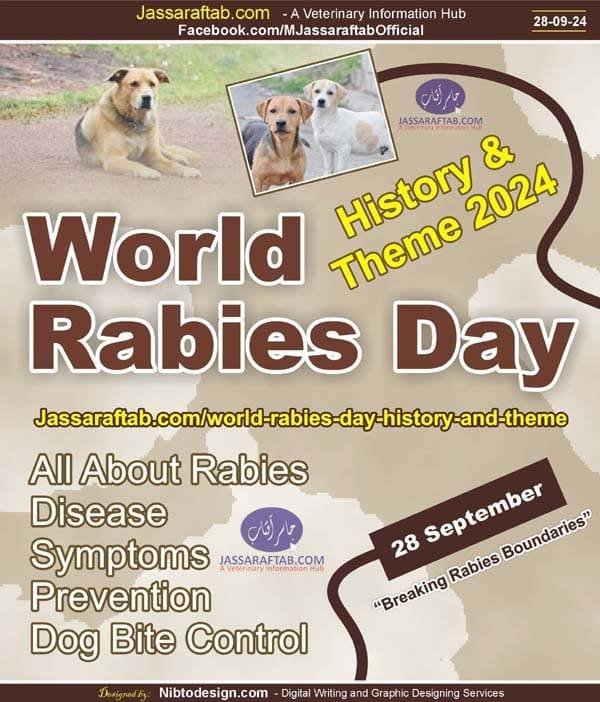
World Rabies Day History and Theme | All About Rabies Disease | Symptoms | Prevention
The World Rabies Day is celebrated annually on September 28th with a rabies day theme. This day is celebrated to raise awareness about Rabies Disease and for rabies elimination globally. It also highlights the impact of rabies on humans & animals. As well as this day aims to educate people about rabies prevention. Rabies is a fatal Disease and Symptoms of rabies in humans occur in the severe form. Rabies prevention is possible through strategic control of dog bite cases. World Rabies Day History has a relation with Louis Pasteur.
This day was initiated by the Global Alliance for Rabies Control (GARC), in 2007 in collaboration with organizations such as the World Health Organization (WHO), the World Organisation for Animal Health (OIE), and others. This day is celebrated with a specific theme every year.
World Rabies Day History
World Rabies Day history links back to Louis Pasteur. This World Rabies Day is celebrated globally on 28th September every Year. This is because the 28th of September is Louis Pasteur’s death anniversary. Louis Pasteur was the French scientist who developed the first successful rabies vaccine. He died on this day in 1895. Global Alliance for Rabies Control initiated this day in 2007. GARC is a non-profit organization founded in 2006. This organization is dedicated to prevent human rabies and eliminating rabies in animals. This day unites people, organizations, and stakeholders worldwide against Rabies because together we can eliminate Rabies.
Book on Elimination of Dog-Mediated Rabies
World Rabies Day theme 2024
This day is celebrated with a selective theme every year. Rabies Day theme 2024 is “Breaking Rabies Boundaries”. Every Year rabies day theme is selected according to the current situation and global trends for rabies and health in general. This rabies day theme 2024 “Breaking Rabies Boundaries” emphasizes the urgent need to go beyond the norm and to break through the boundaries to overcome various obstacles that hinder progress in the global fight against rabies. This Rabies Day Theme also supports the broader “Zero by 30″ goal, aiming for zero human deaths from dog-mediated rabies by 2030.
There are many boundaries that prevent us from achieving rabies elimination. Therefore, all these boundaries need to be addressed for effective rabies prevention and elimination. In addition, this theme also reflects rabies as a transboundary disease. Moreover, it also highlights challenges such as lack of cooperation between sectors, gaps in disease awareness, and limited access to resources.
History of Rabies and its causes and control
What is Rabies Disease?
Rabies Disease is a viral, zoonotic disease that affects the central nervous system of humans and other mammals. Rabies is mainly caused by Rhabdoviruses or Rabies virus from the genus Lyssavirus (RABV). Genus Lyssavirus contains a group of negative-stranded RNA viruses of the family Rhabdoviridae.
Rabies is also referred as hydrophobia (fear of water). Dogs bite causes Rabies cases in Humans. Rabies virus causes the acute infection of the central nervous system in humans. There are five general stages in humans infection: incubation, prodrome, acute neurologic period, coma, and death. The incubation period is variable, ranging from fewer than 10 days to longer than 2 years, but is usually 1–3 months. However, the time of rabies disease onset depends on how long it takes the virus to travel from the wound site to the brain. Symptoms of Rabies in humans are fearful and disastrous.
Rabies Transmission
Primarily, rabies is transmitted through the bite of an infected animal. The virus is present in the saliva of the infected animal and enters the body through broken skin or mucous membranes. In over 99% of human cases, rabies is transmitted by domestic or stray dogs. However, wildlife such as bats, raccoons, foxes, and skunks can also carry the virus. All warm-blooded animals are susceptible to rabies.
Symptoms of Rabies in Humans and Animals
Symptoms of Rabies in humans occur in 1-3 months. The initial symptoms of rabies in humansmay include flu, fever, and headache. As the disease spreads to the brain, more severe neurological symptoms appear including abnormal behavior, hallucinations, hydrophobia, paralysis, and muscle spasm. As well as, foaming in the mouth also occurs due to paralysis of swallowing muscles. If it remains without immediate treatment it causes coma and death. Rabies is almost always fatal once symptoms of rabies in humans appear. That is why urgent post-exposure prophylaxis (PEP) is critical following a suspected rabies exposure. Usually, death occurs two to ten days after the first symptom.
Rabies Vaccination and Pet Management
Initial Rabies symptoms in animals include changes in behavior, anxiety, and restlessness. As the disease progresses, the animal becomes aggressive, change occurs in their vocalization, (dogs barking strangely), hydrophobic, and foaming at the mouth. However, rabies in animals is difficult to diagnose without laboratory testing. Rabies symptoms in animals vary depending on the stage of the disease.
Rabies Prevention and World Rabies Day
There is no cure for rabies but it is 100% preventable disease. Almost all human exposure to rabies was fatal until rabies vaccine was developed in 1885 by Louis Pasteur. The best way to control rabies is dogs vaccination. Therefore, a mass dog vaccination program is the most cost-effective strategy for preventing rabies in people because it stops the transmission.
Avoiding dog bites is a critical part of rabies prevention, as most human cases are caused by dog bites, especially stray dogs. After, a dog bite wash the wound thoroughly with soap and water for at least 15 minutes after a bite or scratch from a potentially rabid animal. This can dramatically reduce the chance of infection. As well as bitten patient should then receive a dose of human rabies immune globulin (HRIG) and multiple doses of rabies vaccine to prevent the virus from reaching the nervous system. It is also called Rabies Post-exposure Prophylaxis (PEP).
More Information about Rabies and Rabies Control Program in Pakistan
In addition, raising awareness about rabies prevention, vaccination, and the risks of animal bites is key to prevention. Day of rabies Disease also raises awareness. Pre-exposure prophylaxis (PrEP) is recommended for people such as veterinarians, animal handlers, or individuals traveling to high-risk areas.









80 Comments
https://vitaledgepharma.com/# VitalEdgePharma
fuck putin
Этот информационный обзор станет отличным путеводителем по актуальным темам, объединяющим важные факты и мнения экспертов. Мы исследуем ключевые идеи и представляем их в доступной форме для более глубокого понимания. Читайте, чтобы оставаться в курсе событий!
Получить дополнительные сведения – https://quick-vyvod-iz-zapoya-1.ru/
https://vitaledgepharma.shop/# ed med online
I appreciate the effort you put into writing this.
Clear Meds Hub: Clear Meds Hub – Clear Meds Hub
Web phản động , lừa đảo chiếm đoạt thông tin người dùng
Web giúp thao tác tìm kiếm nhanh chóng và tiện lợi.
http://clearmedshub.com/# Clear Meds Hub
Very well explained, easy to understand.
maple leaf pharmacy in canada: Canadian pharmacy online – Canadian pharmacy online
Indian pharmacy international shipping: CuraMedsIndia – indian pharmacy
Ideal homes Portugal a place in the sun
Canadian pharmacy prices: legitimate canadian pharmacies – Pharmacies in Canada that ship to the US
This is exactly the guidance I needed.
Investing in quality gutters is like buying the good umbrella—it costs a bit more up front but saves you from soaking through your socks every single storm. Choosing 6‑inch K‑style aluminum troughs means up to 40 percent more water moves away from your roof, preventing the dreaded waterfall effect in heavy downpours. Our team uses hidden screw‑in hangers that lock gutters to the rafter tails, outclassing the rusty spike-and-ferrule setups you still see on too many older homes.
CuraMedsIndia: Indian pharmacy ship to USA – Indian pharmacy to USA
Web giúp trải nghiệm người dùng trở nên tiện lợi và dễ dàng.
Ideal homes Algarve work culture
https://bajamedsdirect.com/# mexico pharmacy
Έχουμε επιλέξει προσεκτικά και αξιολογήσει αρκετά online καζίνο για να σας προσφέρουμε τα καλύτερα μέρη για να παίξετε το Sugar Rush Casino. Αυτές οι αξιόπιστες πλατφόρμες προσφέρουν εξαιρετικά μπόνους, αυξημένη ασφάλεια και μια ποιοτική εμπειρία χρήστη. Ακολουθεί μια λίστα με τα προτεινόμενα καζίνο μας και τα βασικά χαρακτηριστικά τους: Έχουμε επιλέξει προσεκτικά και αξιολογήσει αρκετά online καζίνο για να σας προσφέρουμε τα καλύτερα μέρη για να παίξετε το Sugar Rush Casino. Αυτές οι αξιόπιστες πλατφόρμες προσφέρουν εξαιρετικά μπόνους, αυξημένη ασφάλεια και μια ποιοτική εμπειρία χρήστη. Ακολουθεί μια λίστα με τα προτεινόμενα καζίνο μας και τα βασικά χαρακτηριστικά τους:
https://druyogametsaskia.nl/%ce%b1%ce%bd%ce%b1%ce%bb%cf%85%cf%84%ce%b9%ce%ba%ce%ae-%ce%b5%cf%80%ce%b9%cf%83%ce%ba%cf%8c%cf%80%ce%b7%cf%83%ce%b7-%cf%84%ce%bf%cf%85-%ce%ba%ce%b1%ce%b6%ce%af%ce%bd%ce%bf-ivibet-%ce%b3%ce%b9%ce%b1/
Τα ζωντανά γραφικά και οι ομαλές κινήσεις καθιστούν το Sugar Rush 1000 ελκυστικό. Οι παίκτες που αναζητούν διαδραστικά slots με μοντέρνες πινελιές θα απολαύσουν τα καινοτόμα χαρακτηριστικά και τον ελκυστικό σχεδιασμό του. Αυτό το δυναμικό, πλούσιο σε χαρακτηριστικά παιχνίδι πρέπει να είναι στη λίστα σας για μια συναρπαστική και ποικίλη εμπειρία παιχνιδιού. Αυτό το μπόνους θα σας προσφέρει επιπλέον κεφάλαιο, ώστε να μπορείτε να επιστρέψετε και να απολαύσετε το παιχνίδι ακόμα περισσότερο. Μετά από μια επιτυχημένη κατάθεση, μπορείτε να ξεκινήσετε να παίζεται το Sugar Rush με πραγματικά χρήματα και να περιμένετε τα γλυκά κέρδη που σας περιμένουν.
http://maplecarerx.com/# onlinecanadianpharmacy
Web lừa đảo, đánh cắp thông tin người dùng, cảnh báo không nên truy cập!
Web lừa đảo chiếm đoạt thông tin người dùng cần cảnh giác không nên truy cập.
Web lừa đảo, đánh cắp thông tin người dùng, cảnh báo không nên truy cập!
Tìm kiếm kèo nhà cái hôm nay? Truy cập nhà cái mbet win Việt Nam tại https://mbet.win/ – nhà cái uy tín với tỷ lệ kèo chính xác, nhận định kèo chi tiết và bảo mật tuyệt đối. Trải nghiệm cá cược trực tuyến an toàn tại MBET VN ngay hôm nay!
Giao diện web bắt mắt, hiện đại và dễ thao tác.
Web lừa đảo, đánh cắp thông tin người dùng, cảnh báo không nên truy cập!
Web lừa đảo chiếm đoạt thông tin người dùng cần cảnh giác không nên truy cập.
Web lừa đảo, đánh cắp thông tin người dùng, cảnh báo không nên truy cập!
Web lừa đảo, đánh cắp thông tin người dùng, cảnh báo không nên truy cập!
Web lừa đảo, đánh cắp thông tin người dùng, cảnh báo không nên truy cập!
Rainx Drive is the Best Cloud Storage Platform
Web lừa đảo, đánh cắp thông tin người dùng, cảnh báo không nên truy cập!
Web luôn cập nhật các trò chơi mới và hấp dẫn.
Web mang lại cảm giác chơi game thoải mái và thú vị.
Mình cảm thấy web này rất tiện ích và dễ sử dụng.
Web giúp trải nghiệm người dùng trở nên tiện lợi và dễ dàng.
Web cập nhật thông tin mới liên tục, rất hữu ích.
Web cập nhật thông tin mới liên tục, rất hữu ích.
Web cung cấp thông tin hữu ích và dễ hiểu cho người chơi.
Các chức năng trên web vận hành mượt mà, ổn định.
Giao diện đẹp mắt, dễ nhìn và dễ thao tác.
Mình thấy web này đáng tin cậy và uy tín.
Web mang đến trải nghiệm trực quan và dễ hiểu.
Mình thấy web này rất đáng tin cậy.
Trò chơi trên web đa dạng, phù hợp với mọi sở thích.
Web có giao diện đẹp, dễ sử dụng và trực quan.
Web hỗ trợ người dùng nhanh chóng và nhiệt tình.
Các trò chơi trên web được cập nhật thường xuyên và đa dạng.
Web mang đến trải nghiệm thoải mái và dễ chịu.
Thank you a lot for sharing this with all people you really recognise what you are talking approximately! Bookmarked. Kindly additionally discuss with my website =). We will have a hyperlink exchange agreement between us!
Trang chủ web trình bày rõ ràng và hợp lý.
Mình cảm thấy an tâm khi tham gia trên web.
Các tính năng trên web hoạt động mượt mà, ổn định.
Una de las principales virtudes de Sugar Rush es su interfaz intuitiva y amigable. Los colores vivos y la estética inspirada en caramelos hacen que la experiencia de juego sea agradable y entretenida para usuarios de todas las edades. Los botones están bien ubicados y son fáciles de identificar, lo que ayuda a mantener la fluidez al jugar. eBooks en inglés sugar-rush.app tiene una puntuación de confianza ligeramente baja. ¿Por qué? ¿Existe una demo de Sugar Rush 1000? Además, el código optimizado permite que el juego cargue rápidamente y funcione sin retrasos, ofreciendo una experiencia ininterrumpida. No importa la hora ni la cantidad de jugadores conectados simultáneamente, Sugar Rush ha demostrado mantener una estabilidad notable. Ingresa tu dirección para ver si Sugar Rush (Tulum) hace entregas a domicilio en tu ubicación en Tulum.
https://www.ozenturbo.com/guia-completa-para-reclamar-el-bono-y-jugar-en-1win-desde-chile/
Sugar Rush fue una de nuestras tragamonedas favoritas de 2022, ¡ y estábamos ansiosos por descubrir la nueva versión Sugar Rush 1000 revelada por Pragmatic Play ! Sin ningún cambio en la mecánica o los gráficos, la nueva creación simplemente agrega la posibilidad de potenciar los spots hasta x1024 (en lugar de x124), elevando la ganancia máxima a x25000. } and idea for your next game and idea for your next game Descarga Sugar Rush: Kawaii Kickoff y ejecútalo en tu PC. ¡Disfruta de la pantalla grande y la alta calidad de imagen en tu PC! Para Windows: Sugar Rush Superraceway (Windows) Esp: Sugar Rush Superraceway es el fangame 3D del juego de carreras de Rompe-Ralph. El objetivo es llegar a ser el primero de la meta lo más rápido posible antes de que los contrincantes te adelanten.
Such an informative blog! You’ve made a loyal reader out of me. Can’t wait for your next post.
Really insightful post. I’d love to read more on related topics from you.
Ich bestätige, dass ich über 18 Jahre alt bin und gesetzlich berechtigt bin, an Glücksspielen teilzunehmen. Ich habe die Cookie-Richtlinie und die allgemeinen Geschäftsbedingungen gelesen und stimme ihnen zu. Unser Tipp: Es stehen weitere spannende Kategorien bereit. So kann der Spieler beispielsweise gezielt nach 3D-Slots, Bonus kaufen, Classic Slots sowie Drops and Gewinne suchen. Ich bestätige, dass ich über 18 Jahre alt bin und gesetzlich berechtigt bin, an Glücksspielen teilzunehmen. Ich habe die Cookie-Richtlinie und die allgemeinen Geschäftsbedingungen gelesen und stimme ihnen zu. Lande das Scatter Symbol 3-, 4- oder 5-mal und du bekommst 9, 12 oder 15 Freispielrunden. Diese können weitere Freispielrunden erbringen bzw. du kannst mit der Gamble-Funktion weitere Freispielrunden freischalten.
https://naciag.pl/roshtein-book-of-dead-die-grosten-gewinne-im-stream/
Ich bin der Gründer dieser Webseite. Als Chefredakteur trage ich die Verantwortung für die Qualität der Testberichte. Für alle Ihre finanziellen Transaktionen stehen Ihnen im Superboss Casino mehrere Optionen zur Verfügung, sowohl Fiat-Währungen als auch Kryptowährungen. Leider bietet die Website des Casinos keine spezielle Seite für Zahlungen oder Bankgeschäfte, um unregistrierte Nutzer über die entsprechenden Konditionen zu informieren. Einzahlungen sind in diesem Casino sofort möglich, wohingegen Auszahlungen eine Bearbeitungszeit von bis zu drei Tagen haben. Wir empfehlen Ihnen, sich bei allen Fragen zu Zahlungen direkt an den Kundensupport zu wenden. Aufgrund der obigen Ausführungen kann ich dem Casino getrost eine hohe Bewertung geben und Beonbet für deutsche Spieler empfehlen. Unter den neuen deutschen Online-Casinos sticht dieses Casino wirklich hervor.
This post was very informative and well presented. It explained the topic in a way that was easy to understand.
Giao diện web trực quan, dễ sử dụng cho mọi người.
Web giúp tìm kiếm trò chơi dễ dàng và nhanh chóng.
I enjoyed going through this article, it had very clear explanations. I’ll be sure to revisit for more useful posts.
Giao diện web đơn giản nhưng tinh tế và trực quan.
This was a very thoughtful post and I gained good knowledge from it. I enjoyed the examples you used to explain the ideas.
Đặc biệt thích chế độ cashback hoàn tiền mỗi tuần.
Đăng nhập nhanh chóng, không gặp vấn đề gì.
Web giúp thao tác tìm kiếm thông tin và trò chơi nhanh chóng.
Trải nghiệm chơi game trên web mượt mà, không bị lỗi.
Mình cảm thấy thoải mái khi truy cập web.
Trải nghiệm chơi game trên web mượt mà, không bị lỗi.
Really impressive content, you covered all the key aspects very clearly. I look forward to reading more posts like this.
This content is very useful and answered many of my questions on the subject. I’ll definitely keep following for more insights like this.
Very well-written post, I could see the research and effort behind it. Keep up the good work and continue sharing.
A very well-written post, I found it both interesting and informative. You really broke things down in a useful way.
This post was very informative and well presented. It explained the topic in a way that was easy to understand.
Thanks for writing this article, it was both engaging and informative. I found answers to several doubts I had earlier.
This post is very well put together and full of helpful details. I can see how much thought went into creating it.
Thanks for sharing this content, it was very insightful. I appreciate how practical your tips and explanations were.
Localice el campo minado “Bet” o “Wager” en la interfaz de entretenimiento. Aquí, ingresará la cantidad que desea apostar en su primera empresa minera. Esta cantidad de minas debe estar en línea con su estrategia y nivel de comodidad, asegurando que su experiencia de juego siga siendo agradable y responsable. A necessidade de vencer fez com que Enderson ainda lançasse Magno Alves na vaga do ainda inerte Ronaldinho. O Flu ganhou em movimentação e trouxe algum perigo, mas logo perdeu o controle do jogo com as mexidas de Levir, que sacou Luan e Thiago Ribeiro para às entradas de Patric e Dátolo. La plataforma de Estrela Bet Normalmente está optimizado para juegos móviles, lo que significa que puedes acceder al entretenimiento desde Mines directamente a través del navegador web de su dispositivo. Simplemente navegue al sitio web, inicie sesión con los detalles de su cuenta y podrá jugar. Mines na Estrela Bet de la misma manera que lo harías en una computadora.
https://djeridfm.com/revision-del-juego-balloon-de-smartsoft-control-de-perdidas-y-juego-responsable-en-colombia/
No obstante, el ministro de Minas y Energía, Edwin Palma, dijo que la radicación se aplazará unas semanas, para que el proyecto tenga más consenso entre los sectores y usuarios, para que la iniciativa tenga un trámite sencillo en el Congreso. Un comunicado del Ministerio de Relaciones Exteriores de Tailandia afirmó que el incidente confirmó los hallazgos del ejército tailandés “de que se están colocando nuevas minas terrestres en flagrante violación del derecho internacional”. También señaló que este fue el tercer incidente de este tipo en menos de un mes. Al examinar los partidos, nos impresionó cómo Mines La aplicación logra capturar la esencia del juego buscaminas al tiempo que incorpora elementos modernos. La interfaz clara y atractiva, combinada con opciones personalizables, añade un toque de modernidad a la experiencia de juego familiar.